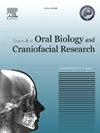Comparative evaluation of ozonized water versus normal saline irrigation with mechanical debridement in chronic periodontitis patients – A clinical study
Q1 Medicine
Journal of oral biology and craniofacial research
Pub Date : 2025-03-31
DOI:10.1016/j.jobcr.2025.03.014
引用次数: 0
Abstract
Background
Ozone therapy is a rather novel approach for managing many diseases, encompassing oral disorders such as tooth caries and periodontal disease. It possesses the ability to disrupt microbial cell walls, resulting in rapid cell lysis. Moreover, characteristics of ozone such as anti-inflammation, stimulation and modulation of immunity contribute to mitigating the host response aspect of periodontal disease.
Objective
To assess the adjunctive advantages of irrigation of ozonized water in conjunction with mechanical debridement for the treatment of periodontitis.
Methodology
50 patients with chronic periodontitis and pocket probing depth ≥4 have been divided into 2 groups i.e. Test (n = 25) and control groups (n = 25). While the control group was administered normal saline irrigation and mechanical debridement, the test group was given ozonized water irrigation. Evaluations were conducted at baseline and four weeks following treatment to determine the plaque score, bleeding score, pocket probing depth, and clinical attachment level.
Results
Clinical measures such as clinical attachment level, pocket probing depth, bleeding index, and plaque index, significantly improved with adjunctive ozone water irrigation. The frequency of sites with bleeding on probing that had a pocket depth ≥4 mm was significantly reduced as a result of ozone water irrigation.
Conclusion
Ozone irrigation alongside nonsurgical periodontal therapy offers adjunctive benefits by reducing clinical parameters.

臭氧水与生理盐水冲洗联合机械清创治疗慢性牙周炎的临床研究
牙带治疗是治疗许多疾病的一种相当新颖的方法,包括龋齿和牙周病等口腔疾病。它具有破坏微生物细胞壁的能力,导致细胞快速裂解。此外,臭氧的抗炎、刺激和调节免疫等特性有助于减轻牙周病的宿主反应。目的评价臭氧水冲洗联合机械清创治疗牙周炎的优势。方法将50例慢性牙周炎患者分为两组,试验组(n = 25)和对照组(n = 25)。对照组给予生理盐水冲洗和机械清创,试验组给予臭氧水冲洗。在基线和治疗后四周进行评估,以确定斑块评分、出血评分、口袋探测深度和临床附着水平。结果辅助臭氧水灌溉后临床指标如临床附着水平、穿刺深度、出血指数、斑块指数均有明显改善。臭氧水灌溉显著减少了穴袋深度≥4 mm的探孔出血部位的发生频率。结论臭氧冲洗配合非手术牙周治疗可降低临床参数,具有辅助疗效。
本文章由计算机程序翻译,如有差异,请以英文原文为准。
求助全文
约1分钟内获得全文
求助全文
来源期刊

Journal of oral biology and craniofacial research
Medicine-Otorhinolaryngology
CiteScore
4.90
自引率
0.00%
发文量
133
审稿时长
167 days
期刊介绍:
Journal of Oral Biology and Craniofacial Research (JOBCR)is the official journal of the Craniofacial Research Foundation (CRF). The journal aims to provide a common platform for both clinical and translational research and to promote interdisciplinary sciences in craniofacial region. JOBCR publishes content that includes diseases, injuries and defects in the head, neck, face, jaws and the hard and soft tissues of the mouth and jaws and face region; diagnosis and medical management of diseases specific to the orofacial tissues and of oral manifestations of systemic diseases; studies on identifying populations at risk of oral disease or in need of specific care, and comparing regional, environmental, social, and access similarities and differences in dental care between populations; diseases of the mouth and related structures like salivary glands, temporomandibular joints, facial muscles and perioral skin; biomedical engineering, tissue engineering and stem cells. The journal publishes reviews, commentaries, peer-reviewed original research articles, short communication, and case reports.
 求助内容:
求助内容: 应助结果提醒方式:
应助结果提醒方式:


